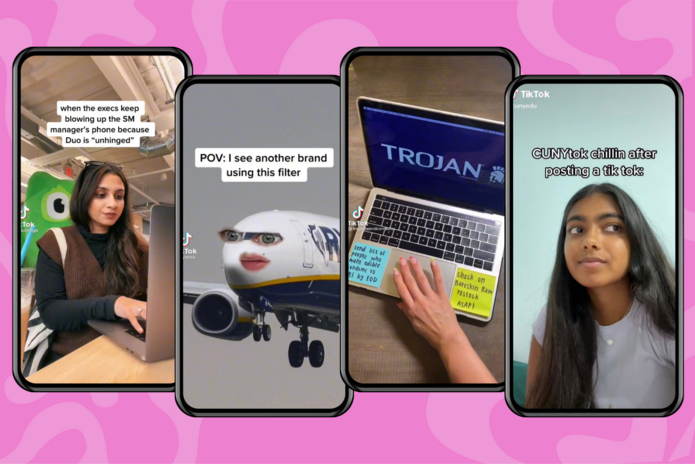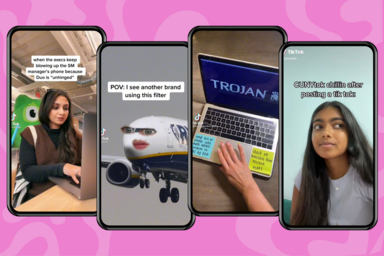TikTok content can run the gamut from hilarious to moving to downright strange, but if there’s one side of the app that has almost everyone cringing, it’s undoubtedly brands on TikTok.
They’re too polished. They’re just reposting content from other platforms. There’s no recurring theme or faces for users to get attached to, or invested in. They’re trying way too hard, either to sell you something or to “blend in,” and not really accomplishing either mission. They try to force-create challenges, sealing their fate of never getting off the ground. Scrolling past ads on TikTok feels a little like seeing the Steve Buscemi “How do you do, fellow kids?” meme come to life. Something’s just kind of… off.
Unlike, say, YouTube ads, which everyone knows and accepts as straightforward advertising, the algorithm mixes brands’ TikToks in with regular users’ content. As a result, brands are not only competing to make themselves more enticing than other advertisers. They’re also up against the high schooler doing dance challenges in their bedroom, and the college student whose off-the-cuff humor will always outwit their marketing execs, and the comedy duo putting out short form sketches riddled with internet slang and inside jokes that, frankly, go over most brands’ heads.
Gen Z is a particularly hard generation to market to. We’re known for using ad blockers and other means to avoid sponsored content. Our prioritization of authenticity from the brands we like to shop at, as explained by Forbes, places brands in a difficult position. They have to strategically and intentionally advertise content while making it seem low-key enough to appeal to their low-key (and sharp-eyed) audience. Considering the ubiquity of “Silence, Brand!” memes in most of these companies’ Twitter replies, it’s not surprising that they often fumble the ball.
And while they may achieve that nuance on platforms like Instagram or Facebook, TikTok is a different monster altogether. TikTok is often hailed as one of the most authentic social media platforms — rather than being dependent on growing your follower count, the algorithm allows anyone to go viral, and relatability is king. Brands can’t sit back and rely on name recognition alone to do the work for them; in fact, it may even hinder their chances of connecting with audiences. People go on TikTok to watch glimpses of real human life and personality, and the sooner brands realize that, the better off their marketing strategy will be.
Some brands have managed to master the personality and humor necessary for success on TikTok. Take Duolingo, for example — they were getting less than 100,000 views on their posts, which mostly included language-learning tips from a mix of forgettable faces, until they introduced the recurring Duo owl mascot. The owl plays Squid Game! It has beef with Google Translate! It’s adorable, relatable, and a little “unhinged,” as one TikTok proclaimed. (See? They’re in on the joke!) Now, they regularly rack up over a million views on their posts. Perhaps most tellingly, their bio isn’t shoving a product link at you or trying to get you to sign up for Duolingo — instead, the app claims they’re “just an owl tryna vibe.”
Ryanair is another big player on Gen Z’s FYP, an impressive feat considering the airline itself is mostly big in Europe rather than the U.S. But simply using a filter to add eyes and a mouth to the plane and making relatable jokes about long flights has helped them gain over a million followers, proving you don’t need to do the absolute most to connect with TikTokers; you just need to do a small thing well. Sometimes that “small thing” is as simple as knowing how to effectively use the comment section, as pointed out by AdWeek. Brands like Trojan (yes, the condom brand) have this down pat, and others are starting to catch on by interacting with more regular users to humanize themselves.
So what’s the key to marketing to Gen Z? Simply put, don’t take yourself so seriously. None of these brands are actively pushing products at their viewers. It’s less about the stuff and more about the attitude; viewers respond better to a person or format than a corporation. A brand’s objective has to be different on TikTok — the focus shouldn’t be on the dollar signs, but instead on gaining respect from an audience that might otherwise mock them.
Advertising becomes a sneaky game of hide-and-seek; the more invisible, the better. It becomes a point of pride — CUNY’s TikTok, run by students, has even made jokes about how not-verified their content seems. Brands like CUNY are actually helping their companies by distancing their content from its source. Honestly, everyone should take a page from CUNY’s book. One of the best things a brand can do for their TikTok content is hire a bunch of Gen Z interns. The more they try to cater to a generation and audience that they’re not a part of, the quicker the house of cards they’ve built their “authenticity” out of will crumble.


